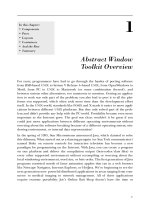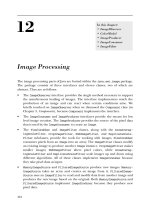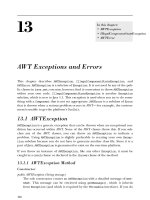Introduction to Java EE (J2EE) pdf
Bạn đang xem bản rút gọn của tài liệu. Xem và tải ngay bản đầy đủ của tài liệu tại đây (648.89 KB, 45 trang )
1
Introduction to Java EE
(J2EE)
2
Lecture Objectives
Understanding the value propositions of J2EE
Getting a big picture of J2EE architecture and
platform
Getting high-level exposure of APIs and
Technologies that constitute J2EE
You don't have to understand all the details
Understanding why J2EE can be used for as a
platform for development and deployment of web
services
3
Challenges
Portability
Diverse
Environments
Time-to-market
Core Competence
Assembly
Integration
Key
Technologies
J2SE
™
J2EE
™
JMS
Servlet
JSP
Connector
XML
Data
Binding
XSLT
Products
App Servers
Web Servers
Components
Databases
Object to DB
tools
Legacy
Systems
Databases
TP Monitors
EIS Systems
Enterprise Computing
4
What Is the J2EE?
Open and standard based platform for
developing, deploying and managing
n-tier, Web-enabled, server-centric, and component-based
enterprise applications
5
The Java™ Platform
High-End
Server
Java Technology
Enabled Desktop
Workgroup
Server
Java Technology
Enabled Devices
6
The Java
TM
Platform
Optional
Packages
Java 2
Enterprise
Edition
(J2EE)
Java 2
Standard
Edition
(J2SE)
JVM
Java
Card
APIs
CardVM
Optional
Packages
Personal
Basis Profile
Personal
Profile
Foundation Profile
CDC
MIDP
CLDC
KVM
Java 2 Platform Micro Edition
(J2ME
TM
)
* Under development in JCP
8
Open and Standard Solution
Use "component and container" model in which
container provides system services in a well-defined
and as industry standard
J2EE is that standard that also provides portability of
code because it is based on Java technology and
standard-based Java programming APIs
9
Platform Value to Developers
Can use any J2EE implementation for development
and deployment
Use production-quality standard implementation which is free
for development/deployment
Use high-end commercial J2EE products for scalability and
fault-tolerance
Vast amount of J2EE community resources
Many J2EE related books, articles, tutorials, quality code you
can use, best practice guidelines, design patterns etc.
Can use off-the-shelf 3rd-party business components
10
Platform Value to Vendors
Vendors work together on specifications and then
compete in implementations
In the areas of Scalability, Performance, Reliability,
Availability, Management and development tools, and so on
Freedom to innovate while maintaining the
portability of applications
Do not have create/maintain their own
proprietary APIs
11
Platform Value to Business Customers
Application portability
Many implementation choices are possible based on
various requirements
Price (free to high-end), scalability (single CPU to clustered
model), reliability, performance, tools, and more
Best of breed of applications and platforms
Large developer pool
12
J2EE
APIs & Technologies
13
J2EE 1.4 APIs and Technologies
J2SE 1.4 (improved)
JAX-RPC (new)
Web Service for J2EE
J2EE Management
J2EE Deployment
JMX 1.1
JMS 1.1
JTA 1.0
Servlet 2.4
JSP 2.0
EJB 2.1
JAXR
Connector 1.5
JACC
JAXP 1.2
JavaMail 1.3
JAF 1.0
14
Java EE 5
JAX-WS 2.0 & JSR 181
Java Persistence
EJB 3.0
JAXB 2.0
JavaSever Faces 1.2 – new to Platform
JSP 2.1 – Unification w/ JSF 1.2
StAX – Pull Parser – new to Platform
15
Servlet &
JSP (JavaServer
Pages)
16
What is a Servlet?
Java™ objects which extend the functionality of a
HTTP server
Dynamic contents generation
Better alternative to CGI, NSAPI, ISAPI, etc.
Efficient
Platform and server independent
Session management
Java-based
17
What is JSP Technology?
Enables separation of business logic from
presentation
Presentation is in the form of HTML or XML/XSLT
Business logic is implemented as Java Beans or
custom tags
Better maintainability, reusability
Extensible via custom tags
Builds on Servlet technology
18
EJB
(Enterprise Java
Beans)
19
What is EJB Technology?
A server-side component technology
Easy development and deployment of Java
technology-based application that are:
Transactional, distributed, multi-tier, portable, scalable,
secure, …
20
Why EJB Technology?
●
Leverages the benefits of component-model on the
server side
●
Separates business logic from system code
−
Container provides system services
●
Provides framework for portable components
−
Over different J2EE-compliant servers
−
Over different operational environments
●
Enables deployment-time configuration
−
Deployment descriptor
21
EJB Architecture
22
Enterprise JavaBeans
Enterprise JavaBeans
Entity Bean Message-Driven Bean
Synchronous communication Asynchronous communication
Stateless
Stateful
Bean managed
Persistence
(BMP)
Container managed
Persistence
(CMP)
Session Bean
23
JMS
(Java Message
Service)
24
Java Message Service (JMS)
Messaging systems (MOM) provide
De-coupled communication
Asynchronous communication
Plays a role of centralized post office
Benefits of Messaging systems
Flexible, Reliable, Scalable communication systems
Point-to-Point, Publish and Subscribe
JMS defines standard Java APIs to messaging
systems
25
Connector
Architecture
26
Connector Architecture
Defines standard API for integrating J2EE
technology with EIS systems
CICS, SAP, PeopleSoft, etc.
Before Connector architecture, each App server has
to provide an proprietary adaptor for each EIS
system
m (# of App servers) x n (# of EIS's) Adaptors
With Connector architecture, same adaptor works
with all J2EE compliant containers
1 (common to all App servers) x n (# of EIS's) Adaptors









